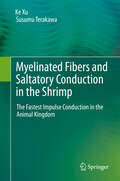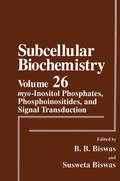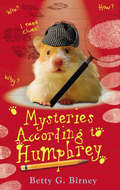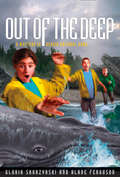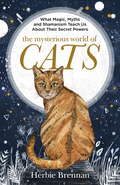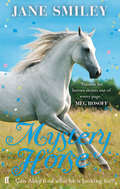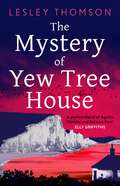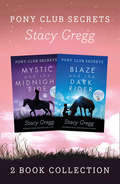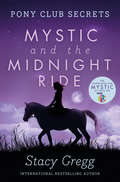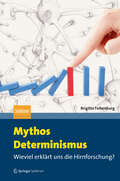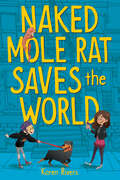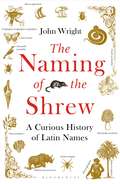- Table View
- List View
Mycoplasmas in Swine
by Dominiek Maes, Marina Sibila & Maria PietersSwine can be infected with many different mycoplasmas. Some are important pathogens, causing significant health and welfare issues in pigs and major losses to the swine industry worldwide. Other mycoplasmas are not pathogenic for swine and can be considered commensals. This book provides up-to-date scientific, clinical and practical information of the most important pathogenic mycoplasmas in swine. Most emphasis has been placed on Mycoplasma hyopneumoniae as the most economically important, but other pathogenic species like Mycoplasma hyorhinis, Mycoplasma hyosynoviae and Mycoplasma suis are also discussed. Written by internationally renowned scientists and clinicians from all over the world, this book draws together in depth knowledge, expertise and experience in swine mycoplasmas to provide an evidence-based, academically rigorous and practical collection. It aims to serve the scientific and veterinary community and the swine industry worldwide.
Mycoses in AIDS Patients
by Geert Cauwenbergh Édouard Drouhet Donald W. R. Mackenzie Jan Van Cutsem Hugo Vanden BosscheThe World Health Organization estimates that at least five million people worldwide are infected with human immunodeficiency virus (HIV) Of these about 100,000 are in Asia and Oceania, 500,000 in Europe, 2 million in the Americas and 2.5 million in Africa (Mann, 1989). The acquired immunodeficiency syndrome is characterized by a derangement in cell-mediated immunity leading to opportunistic infections with for example Mycobacterium spp., Candida spp., Cryptococcus neoformans, Pneumocystis carinii, Toxoplasma gondii and Cryptosporidium. The third symposium on "Topics in Mycology" brought together 265 experts from 32 countries to discuss the epidemiology, immmunological and pathogenetic aspects of AIDS and its opportunistic infections in general and fungal infections in particular. Pneumocystis carinii pneumonia is by far the commonest opportunistic infection in AIDS patients. The nature and classification of P. carinii is still controversial. In search for its true taxonomic affinities an introductory paper formulates a number of key questions. Candidosis is another frequent opportunistic infection. A number of papers discuss the possibility that selective pressures may operate on Candida albicans within the AIDS population and influence its nature: this might have an impact on prophylaxis and curative and/or suppressive therapy.
Mycotoxins in Swine Production
by Ines Rodrigues Maximilian SchuhMycotoxins are not a new topic and they are certainly not a recent worry. In fact, this year it is a decade since theCouncil for Agricultural Science and Technology(CAST) released its scientific task force report on mycotoxins and their impact on plant, animal and human systems. Back then the economic impact of mycotoxins in the United States alone were estimated to exceed $1.4 billion, through losses in commodity quality and health of livestock. This book is intended to be read by those involved in swine production, whether nutritionists or veteriniarians, by students aiming to increase to increase their understanding of the topic, or merely by curious minds. Knowledge has been gathered from several experts and compiled to produce imformation on a wide range of topics from general concepts on mycotoxins by fungi, to their effects on swine performance, fertility and immunity.
Myelin Repair and Neuroprotection in Multiple Sclerosis
by Ian D. Duncan and Robin J. M. FranklinMyelin Repair and Neuroprotection in Multiple Sclerosis presents an up-date on the translational potential of promoting remyelination in multiple sclerosis (MS). A number of research frontiers still exist in this challenging disease. The cause remains elusive, preventing breakthroughs in its prevention. The move towards oral immunomodulatory therapies has been a major advance, as has the finding of new genes linked to susceptibility that may open the door to new therapeutic approaches. However, a frontier that has been making significant strides in recent years has been that surrounding the neurobiology of myelin regeneration and axon protection: such have been the advances that clinical translation is on the cusp of being achieved. Two broad approaches to therapeutic enhancement of remyelination are envisaged: promoting endogenous remyelination by targeting cells present in the CNS, or, replacing lost myelinating cells from exogenous sources. Current research on oligodendrocyte biology, the pathology of MS, imaging of lesions and the biology of remyelination are paving the way toward opening this new translational frontier. Professor Duncan and Professor Franklin have assembled a broad group of experts in the fields of glial cell biology, neuropathology, radiology and clinical neurology to provide the background toward taking remyelination from experimented models into MS patients.
Myelinated Fibers and Saltatory Conduction in the Shrimp: The Fastest Impulse Conduction in the Animal Kingdom
by Ke Xu Susumu TerakawaIn 1961, neurobiologists found that the conduction velocity of the nerve impulse in the giant nerve fiber of the Penaeus shrimp abdominal nerve cord was over 200 m/s, the highest speed of information transmission ever observed in the animal kingdom. The peculiar myelin sheath with its unique nodal structure and the electrical properties of the nerve fibers of the shrimp have continued to be investigated for a quarter of century and are now fully described in this book. The investigation dispels the commonly held belief that the fastest recorded impulse conduction is about 120 m/s in the thickest vertebrate myelinated nerve fibers. In the shrimp, researchers found a completely novel type of functional node in the giant fiber which they designated as the fenestration node. In portions of the myelinated fiber, the fenestration node furnished the sites of excitation. Also discovered was a new strategy for increasing impulse conduction in the shrimp. The book includes a section on the formation of the fenestration node and the discovery of a strategy that allows the shrimp to escape its predators by an action of the fastest velocity. The data presented in this volume on the myelin sheath of invertebrates present a new direction for this field and a rich source of information for neurobiologists worldwide.
Myelination and Demyelination: Implications for Multiple Sclerosis
by Seung U. KimIn June 1987, neurobiologists, immunologists, molecular biologists, virologists and neurologists from several countries met in Vancouver to discuss recent advances of relevance to multiple sclerosis. The symposium was a part of the 22nd Canadian Congress of Neurological Sciences meeting and was sponsored by funds from the Multiple Sclerosis Society of Canada and the Medical Research Council of Canada. The presentations covered five major topics: basic neurobiology, molecular biology, the role of viruses in demyelination, immune function and dysfunction in multiple sclerosis, and clinical magnetic resonance imaging studies. It was heartening to note that scientists from several different disciplines were working towards a common end-point: the understanding and treatment of multiple sclerosis. In this book, speakers at the symposium have each presented a chapter of their findings and discussions. In addition, some non-participants at the symposium have been invited to submit chapters in order to give this volume a more complete scope. It is hoped that the reader will find this book a useful reference for several subjects of interest to multiple sclerosis. In closing, I would like to thank the following for their help and support: the Multiple Sclerosis Society of Canada and the Medical Research Council of Canada for their financial support; the contributors of this book for their manuscripts; Dr. A. Eisen, Mrs. K. Eisen, Mrs. P. Bodnarchuk and Mrs. M. Kim for their efforts in planning and organizing the symposium; and Ms. Catherine Schikowski for her secretarial assistance. Seung U. Kim, M.D. Ph.D.
Myoblast Transfer Therapy (Advances in Experimental Medicine and Biology #280)
by Robert C. Griggs George KarpatiI am pleased to introduce this volume on Myoblast Transfer Therapy on behalf of the Muscular Dystrophy Association and all of its Advisory Committees. The international conference which led to this volume brought together leading basic scientists and clinical investigators for the purpose of coordinating the development of this new field in the fight against muscular dystrophy. The Muscular Dystrophy Association is the nation's most rapidly growing voluntary health agency in terms of its programs of patient care, research, and professional and public education. Success is attributable to its National Chairman, Jerry Lewis, to its effective corporate membership, and to the many physicians and scientists who give their time freely to advise on policies, to review grant applications, and to participate in meetings such as this. I should like to acknowledge a large number of other individuals to whom we are indebted: the broad segment of the American public which continually and generously supports our spectrum of services. The Muscular Dystrophy Association, next year, should raise in excess of $115,000,000. These contributions are derived from more than 10 million American families. These families are not only pledging their money but expressing their hopes that we will find answers to the tragic problem of neuromuscular disease. We are confident that the fruits of this meeting will move the frontier of research forward toward that goal.
Myofibrillogenesis (Cardiovascular Molecular Morphogenesis)
by Dipak K. Dube R. R. MarkwaldMyofibrillogenesis has been studied extensively over the last 100 years. Until recently, we have not had a comprehensive understanding of this fundamental process. The emergence of new technologies in molecular and cellular biology, combined with classical embryology, have started to unravel some of the complexities of myofibril assembly in striated muscles. In striated muscles, the contractile proteins are arranged in a highly ordered three dimensional lattice known as the sarcomere. The assembly of a myofibril involves the precise ordering of several proteins into a linear array of sarcomeres. Multiple isoforms in many of these proteins further complicate the process, making it difficult to define the precise role of each component. This volume has been compiled as a comprehensive reference on myofibrillogenesis. In addition, the book includes reviews on myofibrillar disarray under various pathological conditions, such as familial hypertrophic cardiomyopathy (FHC), and incorporates a section on the conduction system in the heart. Much of the information in this volume has not been described elsewhere. Presented in a manner to be of value to students and teachers alike, "Myofibrillogenesis" will be an invaluable reference source for all in the fields of muscle biology and heart development.
Mysteries According to Humphrey: Mysteries According To Humphrey; Winter According To Humphrey; Secrets According To Humphrey; Imagination According To Humphrey (Humphrey Ser. #8)
by Betty G. BirneyTo celebrate his tenth birthday the whole Humphrey series has a smart new livery, repositioning him alongside perennial favourites such as Winnie-the-Pooh and Paddington.When Humphrey's teacher, Mrs Brisbane, doesn't come to school, he is unsqueakably worried. Then a supply teacher, the mysterious Mr E, arrives and everything changes. Class is fun, but are Humphrey's classmates learning anything? And what had happened to their wonderful teacher? Humphrey has his paws full as he tries to gather clues to solve the mystery, and then, on Halloween, everything is revealed . . .Praise for Humphrey:'An effective exploration of the joys and pains of making and keeping friends, which will strike a chord with many children.' Daily Telegraph'A charming, feel-good tale.' Irish Times'Humphrey's matter-of-fact, table-level view of the world is alternately silly and profound and Birney captures his unique blend of innocence and earnestness.' Publisher's Weekly'Humphrey, a delightful, irresistible character, is big hearted, observant and creative.' Booklist
Mysteries in Our National Parks: Out of the Deep: A Mystery in Acadia National Park (Mysteries in Our National Park)
by Gloria Skurzynski Alane Ferguson National Geographic KidsA baby whale is the latest mammal stranded on the beaches of Acadia National Park. When the Landons run to get help, they don’t notice Bindy Callister slip away. When they track her down, she’s acting strange—she knows the strandings are no accident. She even knows those responsible. But she’s too scared to tell. Time is running out; and now the kids too are in real danger—unless Bindy talks! From the Paperback edition.
The Mysterious World of Cats: The ultimate gift book for people who are bonkers about their cat
by Herbie Brennan'In ancient times cats were worshipped a gods; they have not forgotten this.' Terry PratchettHerbie Brennan is a New York Times bestselling author on the occult who has sold over ten million books world-wide - including in France, Germany and Italy. Here he writes a delightful short but definitive guide to cat lore, weaving together myth, magic, anecdote, fascinating, amusing factoids and even scientific research, complete with beautiful line drawings - from the Egyptian cat goddess Bastet to Macavity the Mystery Cat. Here at last is the book that proves to you that everything you suspected about your cat's uncanny powers of intuition, hypnosis, mind-reading, bi-location and levitation are in fact all true!
Mystery Horse
by Jane SmileyWhen Abby Lovitt gets to work at her family's ranch, she can hardly believe her luck. True Blue is a beauty, a dapple grey, and he needs a new home - his owner was tragically killed in a car crash, and no one has claimed him. Her father is wary, as always. But Abby is smitten. True Blue is a sweetheart, and whenever Abby calls out, "Blue, Blue, how are you?" he whinnies back.But sometimes True Blue seems, well . . . spooked. He paces, and always seems to be looking for something. Or someone. Abby starts to wonder about True Blue's owner. What was she like? What did she look like? And what are the strange whispers Abby sometimes hears when she's with him?
The Mystery Kitten (Holly Webb Animal Stories #44)
by Holly WebbElsa is finding it difficult to make new friends after her family moves house. Then she hears strange, scratching noises at night and discovers a kitten living in the attic! The little cat has gorgeous black fur and so Elsa names him Pepper. Elsa is desperate to keep her lovely new kitten friend. Dad thinks Pepper belonged to the previous owner, but who would leave behind such a beautiful kitten? A new story from best-selling author Holly Webb, perfect for animal-loving children and fans of ZOE'S RESCUE ZOO and MAGIC ANIMAL FRIENDS.
The Mystery of Yew Tree House: The gripping, must-read psychological procedural set during WWII for fans of Elly Griffiths (The Detective's Daughter #9)
by Lesley Thomson'Lesley Thomson at her considerable best - you'll laugh, you'll cry, you'll never guess.' ELLY GRIFFITHS'Always a treat reading Lesley Thomson.' IAN RANKINEighty years of secrets. A body that reveals them all.1940. At Yew Tree House, recently widowed Adelaide Stride is raising her two daughters alone – but it's not just the threat of German invasion that keeps her up at night. She is surrounded by enemies posing as allies and, while war rages, she grows sure that something terrible is about to happen.2023. Soon after Stella Darnell begins her holiday at Yew Tree House, a skeleton is found in a pillbox at the bottom of the garden. The bullet hole in the skull tells her that the person was murdered.This triggers the unravelling of a mystery eighty years in the making. Soon, Stella will learn that Adelaide was right to worry – the fighting might have been happening abroad, but the true enemy was always much closer to home...A unique take on the traditional murder mystery from critically acclaimed author, Lesley Thomson, for fans of Elly Griffiths, Val McDermid and Mari Hannah.'Thomson has created a complex mystery full of psychological suspense, worthy of Barbara Vine. She makes you feel the presence of evil.' THE TIMES'Elegant and spooky... A gripping demonstration that the past is never really the past.' MAIL ON SUNDAYPraise for The Detective's Daughter series:'Cunningly plotted.' Mick Herron 'One of the most original characters in British crime fiction.' Sunday Times
Mystic and Blaze (Pony Club Secrets)
by Stacy GreggSummer special 2-in-1 edition of the first two books in the ‘Pony Club Secrets’ series.
Mystic and the Midnight Ride (Pony Club Secrets #1)
by Stacy GreggThe first adventure in this fresh and fun new pony-club series for all girls who love horses.
Mythos Determinismus: Wieviel erklärt uns die Hirnforschung?
by Brigitte FalkenburgAus Sicht von Neurobiologen regiert das neuronale Geschehen im Kopf unser Bewusstsein. Als Physikerin und Philosophin hinterfragt die Autorin in diesem Buch die Aussagen von Hirnforschern und stellt fest, dass die Neurobiologie an längst überholten mechanistischen Vorstellungen festhält und dadurch zu Fehlschlüssen über den menschlichen Geist und den freien Willen gelangt. Der Band liefert die Grundzüge einer Wissenschaftstheorie der Hirnforschung und weist damit den Weg zu einem differenzierteren Naturverständnis und Menschenbild.
Myxozoan Evolution, Ecology and Development
by Beth Okamura Alexander Gruhl Jerri L. BartholomewThis book provides an up-to-date review of the biology of myxozoans, which represent a divergent clade of endoparasitic cnidarians. Myxozoans are of fundamental interest in understanding how early diverging metazoans have adopted parasitic lifestyles, and are also of considerable economic and ecological concern as endoparasites of fish. Synthesizing recent research, the chapters explore issues such as myxozoan origins; evolutionary trends and diversification; development and life cycles; interactions with hosts; immunology; disease ecology; the impacts of climate change on disease; risk assessment; emerging diseases; and disease mitigation. This comprehensive work will appeal to a wide readership, from invertebrate zoologists, evolutionary biologists and developmental biologists to ecologists and parasitologists. It will also be of great practical interest to fisheries and conservation biologists. The identification of key areas for future research will appeal to scientists at all levels.
Nahrung und Ernährung: Altbekanntes und Neuerforschtes (Verständliche Wissenschaft #39)
by H. GlatzelNahrungsbeziehungen innerhalb der Tierwelt der Namibwüste (Sitzungsberichte der Österreichischen Akademie der Wissenschaften)
by Wilhelm KühneltNaked Mole Rat Saves the World
by Karen RiversCan Kit&’s super-weird superpower save her world? Twelve-year-old kit (with a small k) likes shopping at the flea market with her best friend, Clem, roller-skating, climbing to the roof to look at the stars, and volunteering at an animal shelter. Until suddenly she has a really big, really strange secret that makes life more complicated than she&’s prepared for: Sometimes, without warning, she turns into a tiny naked mole rat. It first happened as kit watched Clem fall and get hurt during a performance with her acrobatic-troupe family on TV. Since then, the transformations keep coming. Kit can&’t tell Clem, because Clem hasn&’t been herself after the accident. She&’s mad and gloomy and keeping a secret of her own: the real reason she fell. Months later, kit and Clem still haven&’t figured out how to deal with all the ways they have changed—both inside and out. Somehow, kit has to save the day. But she&’s no hero, and turning into a naked mole rat isn&’t a superpower. Or is it?
Nala's World: One man, his rescue cat and a bike ride around the globe
by Dean Nicholson**First print run only: exclusive printed endpapers showing more beautiful photographs of Dean and Nala's adventures - pre-order now for a chance to receive!** Instagram phenomenon @1bike1world Dean Nicholson reveals the full story of his life-changing friendship with rescue cat Nala and their inspiring adventures together on a bike journey around the world.When 30-year-old Dean Nicholson set off from Scotland to cycle around the world, his aim was to learn as much as he could about our troubled planet. But he hadn't bargained on the lessons he'd learn from his unlikely companion.Three months after leaving home, on a remote road in the mountains between Montenegro and Bosnia, he came across an abandoned kitten. Something about the piercing eyes and plaintive meowing of the bedraggled little cat proved irresistible. He couldn't leave her to her fate, so he put her on his bike and then, with the help of local vets, nursed her back to health.Soon on his travels with the cat he named Nala, they forged an unbreakable bond - both curious, independent, resilient and adventurous. The video of how they met has had 20 million views and their Instagram has grown to almost 750k followers - and still counting!Experiencing the kindness of strangers, visiting refugee camps, rescuing animals through Europe and Asia, Dean and Nala have already learned that the unexpected can be pretty amazing. Together with Garry Jenkins, writer with James Bowen of the bestselling A Street Cat Named Bob, Dean shares the extraordinary tale of his and Nala's inspiring and heart-warming adventure together.
The Naming of Cats
by T. S. EliotThe Naming of Cats is a difficult matter,It isn't just one of your holiday games;You may think at first I'm as mad as a hatterWhen I tell you, a cat must have THREE DIFFERENT NAMES.The first poem in Eliot's Old Possum's Book of Practical Cats is a brilliant introduction to the fabulous world of Cats, featuring names such as Bombalurina and Munkustrap - made famous by the recent film!The seventh gorgeous Cats picture book with lively and colourful illustrations by Arthur Robins. Perfect for reading aloud, singing or performing!
The Naming of the Shrew: A Curious History of Latin Names
by John WrightLatin names – frequently unpronounceable, all too often wrong and always a tiny puzzle to unravel – have been annoying the layman since they first became formalised as scientific terms in the eighteenth century. Why on earth has the entirely land-loving Eastern Mole been named Scalopus aquaticus, or the Oxford Ragwort been called Senecio squalidus – 'dirty old man'? What were naturalists thinking when they called a beetle Agra katewinsletae, a genus of fish Batman, and a Trilobite Han solo? Why is zoology replete with names such as Chloris chloris chloris (the greenfinch), and Gorilla gorilla gorilla (a species of, well gorilla)?The Naming of the Shrew will unveil these mysteries, exploring the history, celebrating their poetic nature and revealing how naturalists sometimes get things so terribly wrong. With wonderfully witty style and captivating narrative, this book will make you see Latin names in a whole new light.




